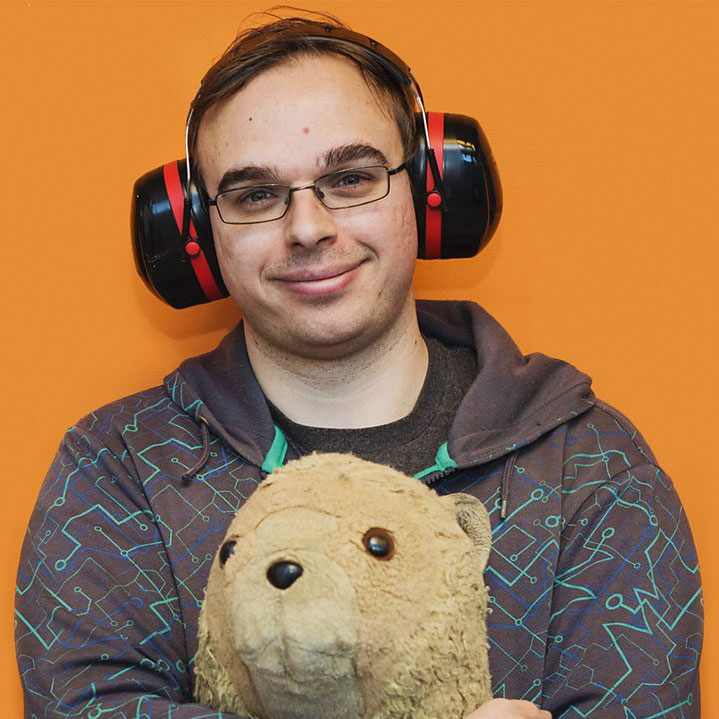Interview with Jamie Knight (and Lion)

Every week, we meet with audience members with disabilities who are willing to come forward and share a little bit about their own personal journey and experiences, attending live, in-person, or virtual speaking or training events. Through their unique and generous perspectives, speakers, trainers, facilitators, and other communication professionals can hopefully learn about some of the things that they do well, but also (and maybe more importantly) about some of the things they could improve to provide an experience that is truly inclusive of everyone.
Meet Jamie (and Lion), an audience member who has autism and mobility issues
So without further ado, let’s dive right into this week’s interview with Jamie Knight (he/him) and Lion. Jamie has autism, mobility issues and comes to us from London, England.
Introductions
QUESTION 01 Can you tell us a bit about yourself, and how your disability might impact your experience, as someone who attends live in-person and virtual events?
I’m Jamie and this is my plush sidekick Lion. I work in tech and Lion’s mostly doing antelope management. I’m autistic and in the past year, I have also had a spinal cord injury. In physical terms, the biggest challenges are all related to moving, sitting, and pain. In cognitive terms the challenges all relate to communication, focus, and comprehension.
Things that ruin the experience
QUESTION 02 Thinking back on some of your experiences attending in-person or virtual events, what are some of the worst things speakers, trainers, and other communication experts can do to ruin your experience as an attendee?
The worst experiences I have had came from three assumptions made during events. The first assumption is that I can speak at a moment’s notice. I can always communicate in one form or another, but I am semi-speaking and an unexpected demand to speak can be very tricky. The second assumption is that I can move. I have very limited mobility and need a harness to sit upright. For that reason, a 10-minute ‘break’ often means sitting alone for 10 minutes as that’s not enough time to unstrap, transfer and move anywhere. The third assumption is about focus. I work best with 30-40 mins of flowy attention. Content that doesn’t flow very well is intensely difficult for me to follow.
Things that make a positive impact
QUESTION 03 Can you share some of the great things speakers, trainers, and other communication experts sometimes do that make a positive impact on your ability to fully enjoy your in-person or virtual event experiences?
For me it comes down to structure. Expressed visually and narratively. Visual structure is all about ensuring I know where I am. This can include things like slide numbers, visually indicated sections (colours, icons etc) and coming back to something consistent at the end of each section. A visual roadmap allows me to pace my energy and focus. Narrative structure is about the concepts. I do best when there’s a story. Start, middle and an end allow me to follow someone down the path. Introducing concepts one at a time and building on them as we go.
Sharing a piece of advice
QUESTION 04 If you had one piece of advice to give speakers, trainers, and other communication experts, so their content became more inclusive of people who have disabilities, what would it be?
Consider the role of communication in all that you do, and try to hit as many channels as possible. I aim to always provide three means of access. The spoken words, the visuals, and something textual or signed. Most folks will be using two of the three. A slide deck designed to be shared is often terrible for a presentation. The visuals of the deck should be communicating the structure of the talk as much as the content of a separate slide. As an attendee, I should be able to know how much of the talk is left by the slides alone. Colour code slides, have big visual changes between sections, etc.
Wrapping up
QUESTION 05 Thank you for sharing some of your insights with us today. As we wrap up our conversation, is there anything that you’d like to add, such as another thought, another piece of advice, another perspective, etc.?
I love for events to be joyful. The most engaging accessible content to me treats any topic in a playful way. Be aware of the assumptions you make about an audience, their body, or their abilities. Assumptions are the root cause of most barriers. If you keep on top of the assumptions, then most of the barriers can be avoided.
Connect with our guest on social
Interested in knowing more about our guest this week? You can follow Jamie and his plush sidekick Lion on LinkedIn and Twitter.

About Denis Boudreau
Denis Boudreau is a consultant, trainer, coach, and speaker specializing in inclusive leadership and inclusive communication. He works with leaders and executives who are no longer willing to overlook disability inclusion and want to transform their leadership approach from “inclusive-ish” to truly inclusive by championing accessibility. A Certified Professional in Web Accessibility (CPWA), Denis has trained thousands of professionals over the past two decades and has delivered hundreds of workshops worldwide in both English and French. He has helped leading brands like Netflix, Salesforce, Victoria’s Secret, and many more embed disability inclusion into their business strategies, empowering them to break down barriers and create deeper, more meaningful connections with their target audiences while also meeting legal obligations.
